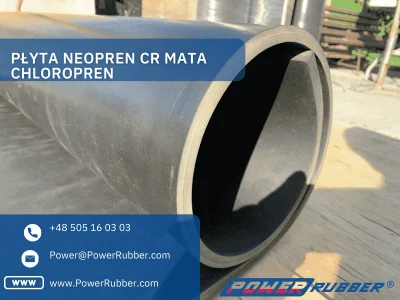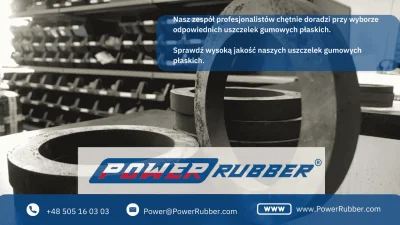CR rubber - Chloroprene Rubber - Neoprene®
CR rubber is Chloroprene Rubber, also known as Neoprene®, a chloroprene polymer. It is one of the first synthetic rubbers. It stands out for its exceptional resistance to ozone. It is also resistant to weather conditions and many chemical compounds. It is also flame-retardant. It has good mechanical properties and a wide range of operating temperatures. Due to its properties, it is widely used in many industries.
What does the abbreviation CR mean?
The abbreviation CR comes from the English language. It stands for chloroprene rubber, which in Polish is kauczuk chloroprenowy.
Thanks to its wide range of properties, it has a wide range of applications in many industries. It is resistant to all types of wear. It is characterized by high abrasion resistance. Chloroprene rubber also stands out for its high resistance to many chemical compounds, such as:
- Mineral oils based on paraffin and silicone greases
- Water and aqueous solutions at moderate temperatures
- Coolants such as ammonia, CO2, freon
- Aging in atmospheric conditions (higher resistance than natural rubber, isoprene, or butadiene-styrene rubber)
- Alcohols and glycols
It has moderate resistance to naphthene-based mineral oils, short-chain aliphatic hydrocarbons such as propane, butane, fuels, and glycol-based brake fluids.
Chloroprene rubber, however, is not resistant to:
- Aromatic hydrocarbons, e.g. benzene
- Chlorinated hydrocarbons, e.g. trichloroethylene
- Polar solvents such as acetone, esters, and ketones
- Petroleum derivatives
- Gas permeability
CR rubber is the right rubber compound for a temperature range: -40°C to +120°C.
Its working temperature range varies from -40 degrees Celsius to +110 degrees Celsius. Briefly, it can even reach +130 degrees Celsius. This is why it is widely used in many industrial sectors. Chloroprene rubber is also characterized by flexibility at temperatures down to around -40 degrees Celsius, making it a better choice than FKM-FPM rubber.
However, it is important to remember that storing it at temperatures below 0 degrees Celsius can lead to irreversible stiffening due to the crystallization process.
Trade names for chloroprene rubber include:
- Neoprene
- Baypren
- Du Pont
- Lanxess
- Butaclor
- Denka Chloroprene
The wide range of properties of neoprene rubber allows for its versatile use in many industries. It is particularly suitable for use in the electronics and automotive industries. Chloroprene rubber, certified with the appropriate attestation, will also find its application in contact with food products. It is also used in the processing of fruits and vegetables, as well as in refrigeration, brewing, and dairy industries. Neoprene rubber is effective for food storage and can be used to seal drinking water systems. Additionally, it is utilized in the production of protective clothing, hoses for cold water, axial rings, rubberizing paper, road marking paints, and adhesives. It is employed in both light and heavy industries.

